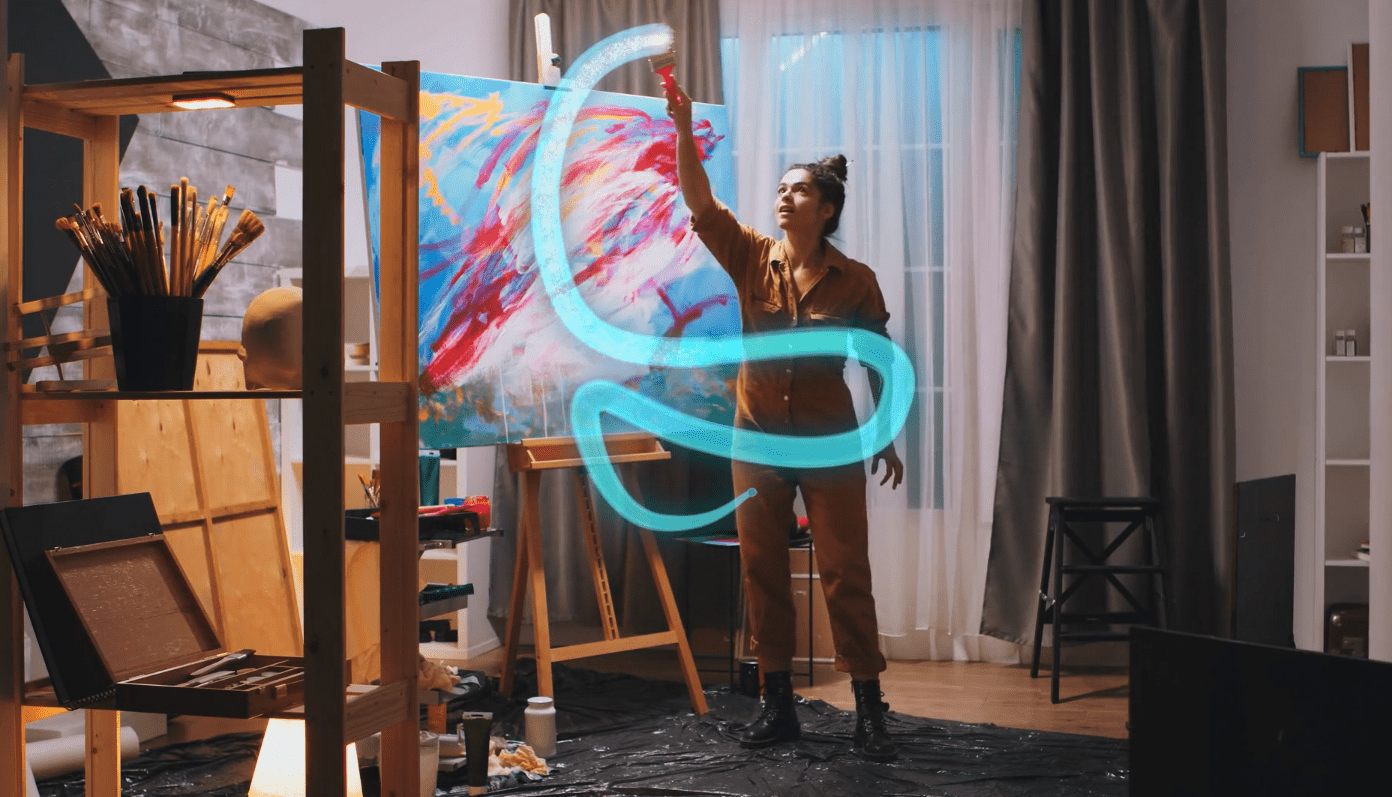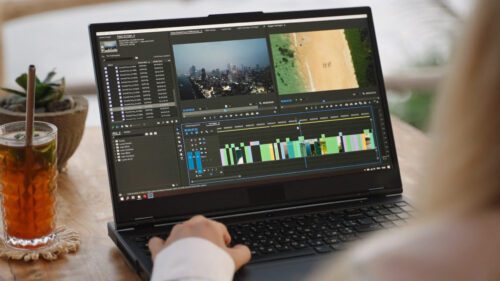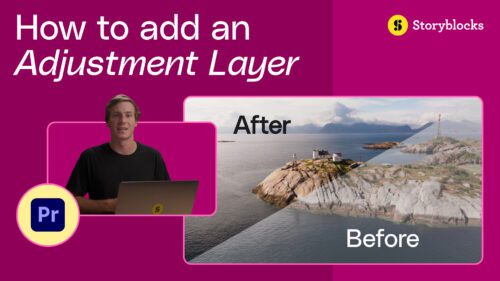Technology has become one of the ultimate storytelling tools, allowing creators to transport their audiences anywhere through visual effects (VFX). Blockbuster movies, video games, and even TV commercials use VFX to immerse viewers and grab their attention. But what is VFX? Simply put, VFX is a method of enhancing reality by creating and incorporating visual elements into live-action footage. VFX helps filmmakers make the impossible possible, whether through creating unique new worlds, fantastical creatures, or breaking the rules of physics.
Introduction to Visual Effects: What Is VFX?
VFX is an umbrella term for special effects that are added to a film during post production using a computer. VFX typically combines live-action footage and enhanced or manipulated imagery to create ultra-realistic environments, characters, and more. The main goal of VFX is to take something that doesn’t actually exist and make it convincingly real. Visual effects can also be practical, such as explosions captured on-set during a car chase.
Visual effects technology has improved exponentially in recent decades. Movies in particular have been at the cutting edge of innovation when using VFX, especially once computers became mainstream. Filmmakers today are able to manifest anything they can imagine on the screen, and that’s all thanks to VFX.
Movies like Avatar and Avengers: Infinity War used VFX in ways that set the bar for modern cinematic effects. Avatar’s VFX brought us the lush world of Pandora, which feels very much lived-in, almost as though it could exist in reality. Infinity War used a combination of CGI and motion capture to convincingly bring supervillain Thanos to life. In both instances the skillful and seamless application of VFX made it easier for audiences to suspend disbelief. Which, especially when dealing with fantasy, is important for making audiences feel immersed.
VFX is also used to create scenes that would be too dangerous or impractical to shoot with real actors or stunt people. Film directors and cinematographers typically work with VFX directors to decide which scenes require visual effects. The movie Gravity takes place in outer space, which would have been impossible to pull off without VFX. And yet, throughout the movie we see characters floating around weightless. We know it’s VFX, but it’s done so well our brains allow us to accept it as real.
Main types of VFX
There are many types of VFX, which serve different purposes depending on the kind of visuals you’re looking to create. Although they vary in style and appearance, they’re all intended to bring the audience deeper into a story. There are more types of VFX than we cover ahead, such as animation, matte paintings, and miniatures. But for our list we wanted to primarily focus on the four main types of VFX, including:
CGI
Computer-generated imagery is the most common form of VFX. CGI is made entirely with VFX software, so it doesn’t use any real-world footage or manipulation. Studios like Pixar have become famous producing 3D animated films that are completely computer generated, like the Toy Story franchise and Finding Nemo. CGI is created using software, but it isn’t only for animated films. Marvel has CGI elements which are then composited into the video, as with Thanos.
Compositing
Compositing is the process of combining multiple images into one. One of the most common compositing techniques is filming with green screens. This is used in all Marvel movies, and many others with a lot of complex visual effects. The actors film their sequences in costume with a green screen behind them. In editing, the green screen is keyed out, and the background, effects, and additional characters are added in with computers.
Motion capture
Motion capture, or mocap, tries to replicate the authenticity of a live performance in digital form. Actors typically perform their scenes on a mocap stage while wearing mocap suits covered in tiny dots. The advanced camera systems record those moving dots and turn it into data. VFX artists then use that data to generate believable digital characters. A good example of this is the actor Andy Serkis as Caesar in Planet of the Apes or Gollum in The Lord of the Rings trilogy.
Rotoscoping
Rotoscoping is an animation technique where motion picture footage is traced over frame by frame to create highly realistic movement. The technique dates back more than 100 years, and was used for many classic Disney animated films like Snow White and the Seven Dwarfs and Alice in Wonderland. More modern examples of films that use rotoscoping include Waking Life and A Scanner Darkly.
What are the differences between SFX and VFX?
Special effects have been used in some form in visual media for over 150 years. Oscar Rejlander created the world’s first special effect in 1857. He combined different parts of 32 negatives to create one single image titled “Two Ways of Life (Hope in Repentance).”
The first motion picture special effect was produced by Alfred Clark in 1895 for “The Execution of Mary Stuart.” The actors were reenacting the beheading of Mary, Queen of Scots. First, an actor dressed as Mary laid her head down on the chopping block. Then, the camera stopped, the actors froze, and the actor was replaced with a dummy. The camera started again, and the executioner brought down his ax to chop off the dummy’s head. Practical special effects like this would dominate the film industry for the next 100 years.
While many people consider the terms VFX and special effects (SFX) interchangeable, there is actually a big difference between them.
Some of the key differences between VFX and special effects include:
| Visual Effects | Special Effects |
| Create effects digitally using a computer. | Use tangible elements like prosthetic makeup and pyrotechnics. |
| Realized in post-production. | Recorded live on set. |
| Digital effects that improve the quality of the visual storytelling. | Practical effects that work with the story as the plot progresses. |
| Enhance, create, or manipulate images for film and other types of media. | Used on-location and rely on models, animatronics, and makeup. |
| Produce elements, like fire and rain, digitally. | Use practical elements, such as fire, fake rain, and snow machines. |
| Usually more costly, time consuming, and difficult to produce because they’re made with computers and require skilled designers. | Tend to be less expensive, faster, and easier to produce. |
| Can be more affordable for large-scale sets, such as adding snow to a mountain landscape. | Difficult to do cost-effectively for large-scale scenes like grand landscapes. |
| Can look “fake” if not done well. | Typically look realistic because they are recorded as they happen in the real world. |
Best of Both Effects Worlds
On most movie sets today, cinematographers rely on a combination of VFX and SFX. There might be cases where you’d use SFX rain in the foreground with the actors and VFX rain for wide shots, for instance. Another example would be if a character is using a flamethrower. They could hold the physical prop but the actual flames are added in using VFX.
Many directors prefer to use special effects as much as possible to give scenes a more authentic feel. This gives viewers a better sense of actors reacting to the heat of an explosion and the intensity of a stunt. Other directors prefer the control that VFX gives them and getting the exact shot that they imagine.
Some use visual effects and special effects simultaneously. In Disney’s 2019 adaptation of Dumbo, the VFX crew created photorealistic 3D clay models of the titular elephant. These physical models were then digitally scanned into a computer and rendered for animation. They even used life-size physical models of Dumbo for the actors to sit on and interact with to ensure they nailed the visual effects scaling.
| Examples of visual effects: | Examples of special effects: |
| Slow motion bullets in The Matrix. | Zombie makeup in The Walking Dead. |
| Flying dragons in Game of Thrones. | Explosions in most action movies. |
| The Hulk in any Marvel movie. | Gunshot wounds and blood in Tombstone. |
| Yoda in the new Star Wars movies. | Yoda in the original Star Wars movies. |
| The liquid metal terminator in Terminator 2. | The miniature town model in Beetlejuice. |
| The car chase scene in Nightcrawler uses rotoscoping and color correction. | Matte painting backgrounds in The Wizard of Oz. |
| Neighborhood crime scene in Zodiac. | Stop-motion in The Fantastic Mr. Fox. |
How Do I Create VFX?
Watching movies can spark a lot of VFX inspiration, but you can’t exactly master the art form from your local multiplex. There are numerous courses and online tools you can use to learn how to create VFX. Some universities even offer degree programs that specialize in VFX.
You can either create VFX from scratch or get a head start by using existing stock video.
From Scratch
If you want to create VFX on your own, first you’ll need some visual effects software. While the best options usually cost money, some free VFX software is available, with varying featuresets. Having a good background in drawing, light composition, modeling, and photography can all help you produce better VFX.
To create VFX from scratch, you’ll also need to record your own footage. You can do this using a smartphone or any other digital device with a camera. To record your footage, you will need to:
Make a VFX shot list
If you are creating a composite shot, think of each shot as another layer. Start with the background and work your way forward.
Choose your locations
Ask yourself: Where is your video or film taking place? What specific considerations do you need to make based on your location? Will you need to film footage from multiple locations?
Match the lighting
If the lighting in your background footage does not match the lighting of your VFX, it will be instantly noticeable. Make sure the lighting matches across all your elements.
From Existing Stock Video
Starting with stock video will give you a great big head start. Some stock footage is even created specifically with VFX in mind. Leveraging these resources should make it much easier to create your composite footage and the end results will likely look cleaner.
Another alternative to using stock footage is filming your own videos and then adding stock visual effects, like snow or explosions.
You’ll find many stock visual effects in the Storyblocks library. We also offer a wide selection of templates for After Effects, Premiere Pro, DaVinci Resolve and many other popular applications. Templates make it fast and easy to insert pre-made VFX into your videos across a range of categories.
What Software Can I Use to Create VFX?
There’s no shortage of video editing applications out there. If your goal is to create convincing VFX, you want software that:
- Can read alpha channel files
- Has blending mode capabilities
- Offers masking options
Some of our favorites include:
1. Adobe After Effects
Adobe After Effects is one of the most popular software applications for VFX. It has hundreds of effects that can be used to manipulate images and videos, and rotoscoping is a snap with its Next-Gen Roto Brush. Using AI, the brush lets you easily and accurately extract objects from footage, requiring much fewer corrections.
However, After Effects has a somewhat steep learning curve, which can be intimidating to newbies or lead to mistakes. However, with a little practice most users start getting the hang of it pretty quickly.
To learn more about how to use After Effects to create stunning VFX, explore our AE tutorials and read through our beginner’s guide. Once you know the basics, test out your new skills on our After Effects Templates. Looking to streamline your workflow? The Storyblocks After Effects plugin allows you to search, preview, and download assets from our library straight from your editor.
2. DaVinci Resolve
DaVinci Resolve is a powerful and richly featured video editing program. It offers cutting, color grading, keyframing, and audio tools. It even lets editors transcribe audio directly within clips for media searches based on narrative content. It’s added AI-powered tools like voice isolation track FX, which lets you remove annoying, unwanted sounds from voice recordings.
The interface is well designed and includes a motion editing tool. If you’re looking to quickly add professional effects in DaVinci Resolve, explore our wide selection of customizable templates. There’s no faster way to add motion graphics, visual effects, and animated sequences to your next video in DaVinci Resolve. All powered by Storyblocks’ vast stock media library.
3. HitFilm Pro
This software offers a unique blend of visual effects, video editing, and 3D compositing in one product. It has a generally user-friendly design that makes it easier for beginners to start with. Frequently used for big-budget Hollywood movies, HitFilm Pro’s robust feature set gives you easy access to a multitude of useful VFX tools. It particularly shines when it comes to chroma keying, particle effects, and 2D and 3D motion tracking.
4. Nuke
Nuke is a powerful video editing and VFX tool used by both professionals and beginners. It features over 200 nodes and is packed with advanced compositing tools. Nuke has also started using machine learning technology in its timeline. This allows users to “audition” effects like matte generation or beauty-fix work across multiple shots simultaneously. Nuke also supports leading industry technology like Open EXR.
5. Houdini
Houdini is one of the most advanced visual effects and video editing programs available. It features an advanced fluid dynamics system, and expert tools for character animation, like its KineFX toolset. KineFX brings together a range of effects like motion capture and keyframe animation for unprecedented realism. Houdini offers fast rendering times, and impressive fur and hair tools.
How Storyblocks Helps People Tell Better Stories
Creating VFX has never been more accessible than it is right now. And pre-made templates make it simple to include CGI in virtually any video. Storyblocks offers a huge selection of VFX templates across DaVinci Resolve, After Effects, Apple Motion, Premiere Pro and more. Start experimenting and let your imagination run wild. Before you know it you’ll be grabbing your audience’s attention with advanced effects, which are made simple with a Storyblocks subscription.
Editor’s Note: This post has been updated to include additional information. It was originally published on May 17, 2022.



